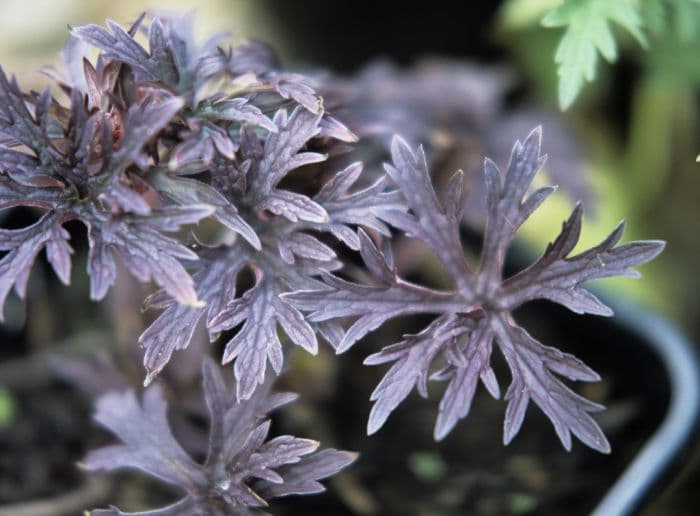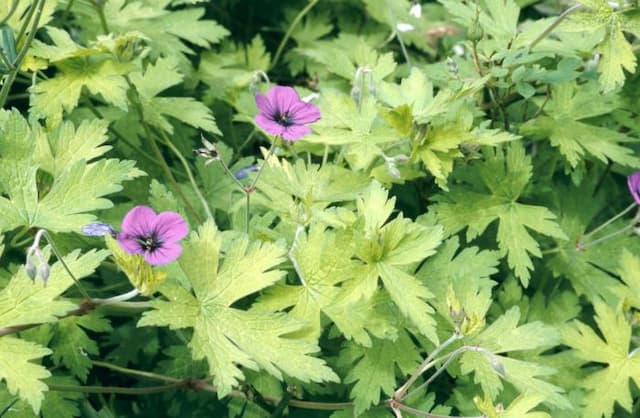Meadow Cranesbill Geranium pratense (Victor Reiter Group) 'Midnight Reiter'

ABOUT
The 'Midnight Reiter' is cherished for its deeply colored foliage and striking flowers. The leaves are highly distinctive, presenting a rich, dark purple hue that makes the plant stand out dramatically in the garden. This dark foliage creates a wonderful contrast that highlights the plant's own flowers and those of neighboring plants. The blossoms are equally enchanting, typically appearing in an uplifting shade of violet-blue. They are carried atop the dark leaves in loose clusters, which enhance their visual impact. Each flower is neatly cupped, with delicate petals that overlap slightly to form a classic, rounded shape. The center of each flower often features subtle veining, contrasting slightly with the main petal color, and adding to the flower's depth and texture. With these captivating characteristics, the 'Midnight Reiter' makes a bold statement in any garden setting, celebrated for both its foliage and the charming flowers that seem to float above the dramatic leaves. The resulting aesthetic is one of a deep, moody background accented by spots of vibrant color, making it a favorite among gardeners seeking to add some visual excitement to their plantings.
About this plant
 Names
NamesFamily
Geraniaceae
Synonyms
Midnight Reiter Cranesbill, Meadow Cranesbill, Hardy Geranium
Common names
Geranium pratense 'Midnight Reiter'.
 Toxicity
ToxicityTo humans
The Meadow Cranesbill, known by its botanical name as Geranium pratense, is generally considered to be non-toxic to humans. There are no well-documented cases of poisoning or significant adverse reactions from ingesting or handling parts of the plant. Thus, accidental ingestion is not likely to cause harm, but as with any plant material, individual sensitivities can vary, and it is always advisable to avoid consuming parts of ornamental plants.
To pets
The Meadow Cranesbill is also considered to be non-toxic to pets. It does not contain known toxins that would be harmful to cats, dogs, or other domestic animals if ingested. As with humans, it is always best for pets to avoid eating non-food plants, as individual animals might have sensitive reactions or experience gastrointestinal upset from ingesting plant material. However, toxicity and subsequent poisoning symptoms are not typically a concern with this plant.
 Characteristics
CharacteristicsLife cycle
Perennials
Foliage type
Deciduous
Color of leaves
Purple
Flower color
Blue
Height
1 foot (30 cm)
Spread
1 foot (30 cm)
Plant type
Herb
Hardiness zones
4
Native area
Europe
Benefits
 General Benefits
General Benefits- Aesthetic Appeal: Adds deep purple foliage and striking violet-blue flowers to gardens, enhancing the visual interest of the space.
- Attracts Pollinators: The flowers attract bees, butterflies, and other beneficial insects, supporting biodiversity.
- Drought Tolerant: Once established, it can withstand periods of dry weather, reducing the need for frequent watering.
- Easy Maintenance: Generally low-maintenance, requiring minimal care once it is planted in the right conditions.
- Cold Hardy: Can survive in colder climates, making it suitable for gardens in USDA zones 4 through 8.
- Compact Growth: Its relatively small size allows it to fit well in smaller gardens or as part of a border without overwhelming the space.
- Seasonal Interest: Provides changing visual interest throughout the growing season from its foliage and flowers.
- Edging Plant: Works well as edging along paths or garden borders due to its mounding growth habit.
- Container Gardening: Suitable for growing in containers which allows for versatility in placement and design within the garden or on patios.
 Medical Properties
Medical PropertiesThis plant is not used for medical purposes.
 Air-purifying Qualities
Air-purifying QualitiesThis plant is not specifically known for air purifying qualities.
 Other Uses
Other Uses- As a natural dye: The deep-colored foliage and flowers of the Geranium pratense can be used to create natural dyes for fabrics and wool.
- Ink production: The pigments found in the plant could potentially be harvested to make organic, non-toxic inks for art or printing.
- Craft decoration: Dried flowers and leaves of the Geranium pratense can be used in decorative crafts like potpourri or wreaths to add a touch of color and rustic charm.
- Photography subject: With its striking dark foliage and vibrant flowers, this plant makes an excellent subject for botanical photography or as part of a garden feature in landscape photography.
- Educational tool: It can serve as a study specimen in botany classes to demonstrate plant structure, physiology, and the impact of selective breeding on plant traits.
- Gardening workshops: This plant could be used in horticultural therapy sessions or gardening workshops focusing on ornamental plant cultivation and care.
- Culinary garnish: Though not commonly used for culinary purposes, the petals of the Geranium pratense can sometimes be used as a decorative, edible garnish in salads or on desserts.
- Flower pressing: The blooms can be pressed and preserved for use in crafts, such as handmade greeting cards, bookmarks, or framed botanical art.
- Soil health indicator: As with many plants, the Geranium pratense can help indicate the health of the soil in which it's grown, displaying certain characteristics in response to nutrient levels and pH balance.
- Companion planting: Though not its primary use, some gardeners might plant Geranium pratense near vegetables or other flowers as part of a companion planting strategy to enhance biodiversity and attract pollinators.
Interesting Facts
 Feng Shui
Feng ShuiThe Geranium is not used in Feng Shui practice.
 Zodiac Sign Compitability
Zodiac Sign CompitabilityThe Geranium is not used in astrology practice.
 Plant Symbolism
Plant Symbolism- Unexpected Meeting - The geranium, in general, can represent an unexpected encounter, as these plants have a habit of popping up where they’re not necessarily planted or expected.
- Friendship - Often, geraniums symbolize closeness and friendship, possibly due to their long-lasting nature and how they can thrive in a garden among many other plants.
- Health and Wellness - Given their use in traditional medicine and their hearty nature, geraniums are also known to represent good health and a wish for wellness.
- Ingenuity - The cranesbill, another name for the wild geranium, is derived from the Greek word 'geranos', meaning crane, due to the seed pods resembling a crane's bill. As cranes are often symbols of ingenuity, this connection extends to the geranium.
 Water
WaterHardy geraniums, such as 'Midnight Reiter', should be watered deeply once a week, providing about 1 to 1.5 inches of water to help establish a strong root system. During extended periods of drought or extreme heat, slightly increase the frequency to ensure the soil remains moist but never waterlogged. It's crucial to avoid overhead watering to prevent leaf spots and other fungal diseases; instead, apply water directly to the base of the plant. In the winter months, reduce watering as the plant requires less moisture during dormancy.
 Light
Light'Midnight Reiter' hardy geranium thrives best in full sun to partial shade conditions. Choose a location where the plant can receive at least four to six hours of direct sunlight daily, which promotes healthy growth and abundant flowering. Morning sun and afternoon shade is an ideal environment, especially in regions with hot summers, to protect the foliage from scorching.
 Temperature
Temperature'Midnight Reiter' hardy geraniums are adaptable to a range of temperatures and can survive winter lows down to about -20 degrees Fahrenheit. They grow best when daytime temperatures are between 65 and 75 degrees Fahrenheit. However, they can tolerate higher temperatures if they are given adequate shade during the hottest part of the day.
 Pruning
PruningPrune 'Midnight Reiter' hardy geraniums in early spring to remove any dead or damaged foliage and to shape the plant. Deadheading spent flowers throughout the growing season will encourage additional blooming. Perform a more substantial cutback after the first flush of flowers has faded to rejuvenate the plant and promote a second bloom.
 Cleaning
CleaningAs needed
 Soil
SoilThe best soil mix for the Hardy Geranium 'Midnight Reiter' should be well-draining and fertile with a slight preference for alkaline to neutral pH levels, somewhere around 5.8 to 7.2. A mix of garden soil, compost, and perlite or sand to improve drainage would be ideal. Regular mulching can help maintain soil moisture and nutrient levels.
 Repotting
RepottingThe Hardy Geranium 'Midnight Reiter' typically does not need to be repotted often if planted in the ground. However, if grown in containers, repotting every 2 to 3 years or when the plant outgrows its pot is recommended to refresh the soil and allow room for growth.
 Humidity & Misting
Humidity & MistingHardy Geranium 'Midnight Reiter' is adaptable and does not require specific humidity conditions. It grows well in the average atmospheric humidity found in most outdoor garden settings.
 Suitable locations
Suitable locationsIndoor
Place in bright, indirect light; ensure well-draining soil mix.
Outdoor
Plant in partial sun, moist soil, and mulch annually.
Hardiness zone
4-8 USDA
 Life cycle
Life cycle'Midnight Reiter' hardy geranium, a variety of Geranium pratense, begins its life cycle with seed germination, typically in early spring, when temperatures rise and days lengthen. Seedlings emerge and develop into young plants with characteristic deeply lobed, dark purple leaves. As the season progresses into late spring and summer, the plant enters a vigorous growth phase, producing tall flowering stems that bear numerous small, violet-blue flowers. After pollination, often facilitated by bees and other insects, the flowers develop into seed capsules that propel seeds away from the parent plant to start a new generation. In the fall, the above-ground parts of the plant die back as it enters a period of dormancy, but the root system remains alive underground. The following spring, the plant re-emerges from the root stock, completing the perennial cycle of the 'Midnight Reiter' hardy geranium.
 Propogation
PropogationPropogation time
Spring-Early Summer
The most popular method of propagation for the 'Midnight Reiter' Hardy Geranium is by division. This process is ideally done in early spring or fall, when the plant is not in active growth. Begin by gently lifting the plant from the ground with a spade, ensuring to keep a good amount of soil around the roots. With a sharp knife or spade, divide the rootball into smaller sections, each with several shoots and a fair amount of roots. Replant the divisions immediately at the same depth they were previously growing, spacing them about 12 to 18 inches (approximately 30 to 45 centimeters) apart to allow for ample growth. Water the newly planted divisions thoroughly to help establish them in their new locations. This method of division helps to rejuvenate older plants while also creating new ones for further garden use or sharing with fellow gardeners.









